Gardeners are often counseled toward selecting “native plants” in their choice of groundcover, shrubs and landscaping flora. Makes sense, but some of the traditional favorites—crepe myrtle and butterfly bush come to mind—don’t qualify since they originated in China. Bummer. So what are the alternatives?
In the United States, a native plant is one that was naturally found in a particular area before European settlement. These plants are the foundation of a region’s biodiversity, providing essential food sources and shelter for wildlife. To understand the interconnectedness of plants and wildlife, consider this example: It takes over 6,000 caterpillars to feed a single brood of chickadees. Caterpillars thrive in native plants, so without them, that bird population would suffer. And chickadees are not unique: In the United States, 432 species—more than one-third of all birds—eat insects, and could risk local extinction in urban and suburban areas without a plentiful supply. This symbiotic relationship is one we can support with attention to what we grow in our own yards, relying primarily on native plants.
As a bonus for the home gardener, native plants are adapted to local precipitation and soil conditions and thus require less upkeep, helping the environment and saving time, water and money.
noteable natives
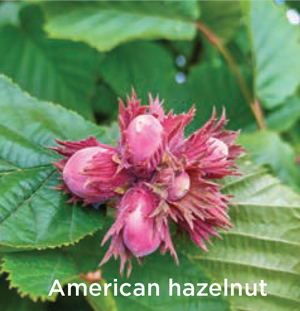 ✿ A nice option for non-native butterfly bush, which can become invasive, is the American hazelnut (Corylus americana), a multi-stemmed shrub that is host for more than 120 butterfly species and moth caterpillars. And its fruits are loved by large birds like blue jays and woodpeckers.
✿ A nice option for non-native butterfly bush, which can become invasive, is the American hazelnut (Corylus americana), a multi-stemmed shrub that is host for more than 120 butterfly species and moth caterpillars. And its fruits are loved by large birds like blue jays and woodpeckers.
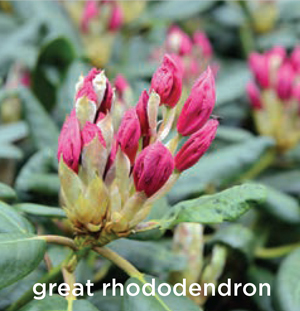 ✿ If you’re looking for big impact, consider great rhododendron (Rhododendrum maximum), also known as Rosebay or Great Laurel, that can become a large shrub—up to 20 feet tall—with showy pale pink or white flowers in large clusters. It blooms in late spring or early summer.
✿ If you’re looking for big impact, consider great rhododendron (Rhododendrum maximum), also known as Rosebay or Great Laurel, that can become a large shrub—up to 20 feet tall—with showy pale pink or white flowers in large clusters. It blooms in late spring or early summer.
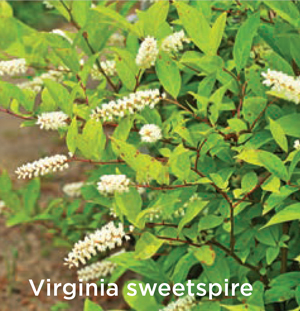 ✿ Virginia sweetspire (Itea virginica), also called Virginia willow, is an arching, mediumsized shrub that grows to 6 feet tall. In late spring to early summer, it has tiny white flowers on 2- to 6-inch arching spikes. Adding to the wow factor: Its leaves turn bright red and remain on the shrub long into the autumn.
✿ Virginia sweetspire (Itea virginica), also called Virginia willow, is an arching, mediumsized shrub that grows to 6 feet tall. In late spring to early summer, it has tiny white flowers on 2- to 6-inch arching spikes. Adding to the wow factor: Its leaves turn bright red and remain on the shrub long into the autumn.
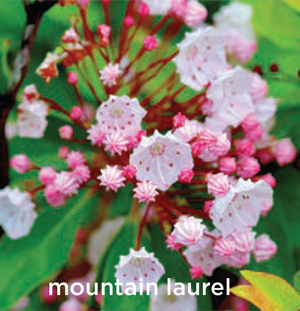 ✿ Another favorite is mountain laurel (Kalmia latifolia) which grows to 10 feet tall and, in late spring to early summer, has flowers that are white to pink in showy clusters.
✿ Another favorite is mountain laurel (Kalmia latifolia) which grows to 10 feet tall and, in late spring to early summer, has flowers that are white to pink in showy clusters.
✿ For more conspicuous blooms, choose Summersweet (Clethra alnifolia), a deciduous medium-sized shrub. Ruby Spice has pink blooms with a delightful fragrance that perfumes your yard and attracts summer insects. An added plus is its long bloom time.
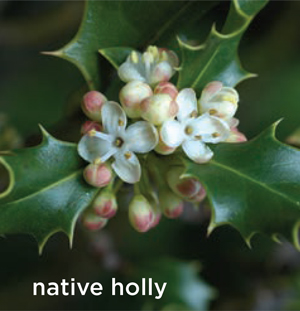 ✿ Virginia is home to several native species of holly including American holly (Ilex opaca), inkberry (Ilex glabra), yaupon (Ilex vomitoria), and the deciduous winterberry (Ilex verticillata), a deciduous shrub that produces plentiful berries that last all through the next winter. In spring, thousands of sweet-smelling, miniature white flowers on a holly become magnets for bees, butterflies, and other pollinators providing forage for these critters. Assuming the female plant has a male plant nearby, as the growing season progresses, the pollinated flowers will give rise to berries, which in turn will provide food for birds and other wildlife. Trees and shrubs provide not only nectar, pollen and fruit but also much-needed cover for wildlife including places for birds to build nests.
✿ Virginia is home to several native species of holly including American holly (Ilex opaca), inkberry (Ilex glabra), yaupon (Ilex vomitoria), and the deciduous winterberry (Ilex verticillata), a deciduous shrub that produces plentiful berries that last all through the next winter. In spring, thousands of sweet-smelling, miniature white flowers on a holly become magnets for bees, butterflies, and other pollinators providing forage for these critters. Assuming the female plant has a male plant nearby, as the growing season progresses, the pollinated flowers will give rise to berries, which in turn will provide food for birds and other wildlife. Trees and shrubs provide not only nectar, pollen and fruit but also much-needed cover for wildlife including places for birds to build nests.
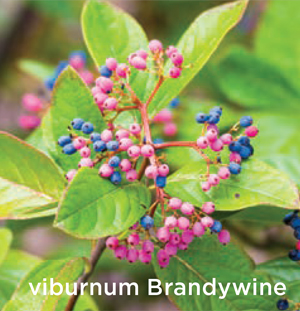 ✿ A native alternative to the popular burning bush (Euonymus altus), a prodigious seed producer whose seeds are spread by birds thereby displacing native plants, is the viburnum Brandywine (Viburnum nudum). It has stunning glossy red leaves in the fall and vibrant berries. This native plant gives food and shelter to wildlife and provides a red wow factor in the garden. ✦
✿ A native alternative to the popular burning bush (Euonymus altus), a prodigious seed producer whose seeds are spread by birds thereby displacing native plants, is the viburnum Brandywine (Viburnum nudum). It has stunning glossy red leaves in the fall and vibrant berries. This native plant gives food and shelter to wildlife and provides a red wow factor in the garden. ✦
